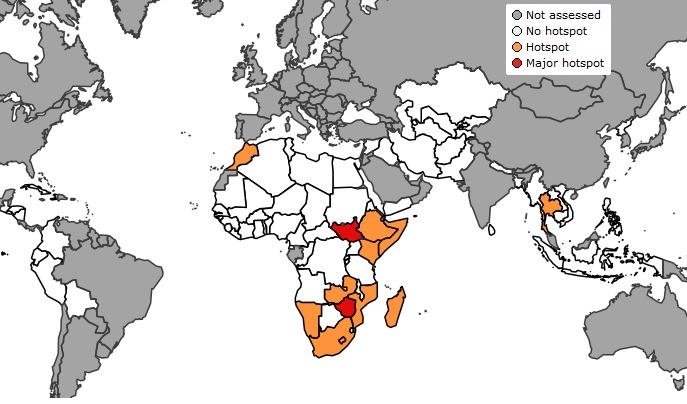Desert locusts threaten next crop season in East Africa, while floods and drought reduce production prospects in Southern Africa

Related topics
Cereals Crop production Drought Flood Food security Monitoring Natural disaster Global Food and Nutrition Securitydate: 04/03/2020
permalink: Main URL
The February edition of the JRC's Anomaly Hotspots of Agricultural Production (ASAP) assessment is now available at:
Anomaly Hotspots of Agricultural Production (ASAP) assessment
Main findings of the February global overview:
- Reduced production prospects for parts of Southern Africa that have been experiencing erratic rainfall patterns. Some areas, such as central Mozambique, eastern Zambia, Zimbabwe and Malawi, have been affected by heavy rains and flooding, while in others, such as coastal and southern Namibia, southern Mozambique, Zimbabwe and southern Zambia, drought conditions persist. By contrast, favourable maize output is expected in South Africa, thanks to good rains received since December over the main producing regions.
- High humidity and greenness of vegetation in East Africa resulted in exceptional development of desert locusts in Ethiopia and Somalia in December 2019. These have expanded to Kenya in 2020, and reached northern Uganda and South Sudan in February. Desert locusts pose a threat to the main grain and livestock-producing areas in the region during the next crop season, further decreasing food security for highly vulnerable populations.
- Rainfall deficits and high temperatures in North Africa are posing a risk to winter crop performance. Below-average crop conditions have already been observed in south-western Morocco, while in Algeria and Tunisia there is no visible impact yet.
- Good conditions prevail for winter cereals in Central and South Asia, even in areas that experienced below-average rainfall in the last three months (e.g. northern Afghanistan and southern Tajikistan).
- In South-East Asia, the dry season rice area in Thailand is reduced due to shortages of irrigation water. By contrast, the rice area in Indonesia is increasing, and crop conditions in Timor-Leste are generally good, except for pockets where the planted area for paddy rice is lower than in 2019.
- In Central America, harvest of the postrera is completed and yields are close to average; harvest of the apante bean season is ongoing in Nicaragua and Honduras, with positive prospects thanks to favourable rains during the season.
The next assessment is scheduled for the end of March 2020.
